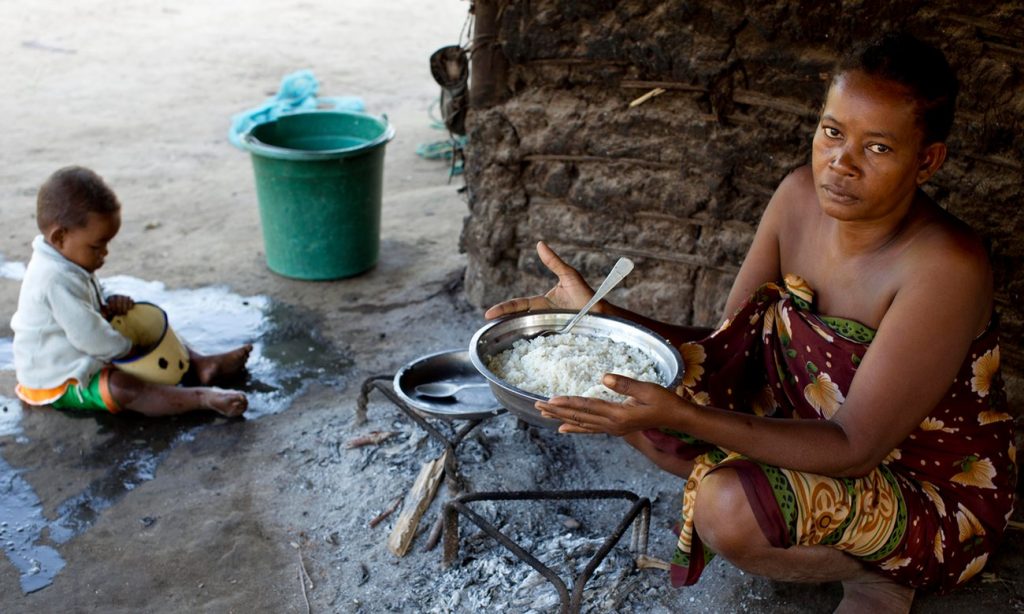
“Do you think giving my daughter this to drink makes me happy?” asks Perline as she holds out a cup of putrid brown water for Felasoa*, eight, one of her four children. “I know this water makes us all sick. But if a human being doesn’t drink, we die. So we have no choice.”
The dirty water was collected from one of the small streams that run by the paddy fields near Bekalalao village in Madagascar. The streams irrigate the fields and provide drinking and bathing water for humans and animals.
At a nearby pond Monja and her daughter Sandra, 10, are collecting water. “We get a lot of stomach aches, and have to go to the doctor – which is expensive …When my husband gets sick he can’t work in the fields so we have nothing to eat. And when the children get sick they can’t go to school.”
Monja points to her 18-month-old baby playing on the floor. “She has had a bad stomach at least six [times] since she was born. I fear this is why she can’t walk yet,” she says.
Madagascar has one of the world’s highest (pdf) rates of stunting, a condition caused by chronic malnutrition during the first 1,000 days of life. Stunted children don’t grow properly, physically or cognitively. It can translate into poor health and affect school and employment in later life.
The World Health Organisation (WHO) estimates that about 160 million children under the age of five are stunted. A 2013 report in the Lancet said a quarter of all cases of stunting are estimated to be directly caused by chronic diarrhoea in the first two years of life.
In Madagascar, half of under-fives are stunted. Lovy Rasolofomanana, director for WaterAid Madagascar, says the causes are complex. “In some parts of Madagascar we have bad drought and people clearly don’t have enough to eat, but in other places they do have enough food but they don’t understand what they need to be eating.
“People might grow rice and other vegetables but they will only eat the rice and sell the vegetables to bring money into the family, or they will eat cassava but boil it so dry that there are no nutrients left.”
He adds: “Tackling malnutrition is not just about food. It is about providing safe water, decent toilets and soap for washing. In Madagascar, almost 90% of the population have no toilet and half don’t have access to clean drinking water.”
A report by WaterAid, Caught short (pdf), released on Tuesday reveals the extent of the problem globally, with half of all cases of under-nutrition estimated to be associated with repeated diarrhoea, intestinal worms and other infections as a direct result of poor sanitation and dirty water.
Rasolofomanana says: “Children’s bodies need relief from the constant diarrhoeal and worm infections they get. Whatever nutrients they might be getting from food, they lose from the infections. Only 30% of Malagasy schools have latrines, so children aren’t safe from diseases at school either.”
At Bestesda primary school, a few miles from Bekalalao, the effects of stunting are visible. In a class of 40 eight-year-olds, more than half of the children look at least three years younger. At break time several children run into the trees just outside the classroom to defecate. Headteacher Solo Mariza says that in the summer months the classrooms smell so bad that children struggle to concentrate.
“They also don’t have anything to drink all day, so they get very tired and thirsty,” she says. The only water source in the school is a well, with just a few feet of water covered with floating debris.
Mariza says that generally the children do have enough to eat. “Their families grow rice and they eat that and other crops. I think water is a bigger problem for their health than lack of food. We know about hand washing but we don’t have enough water in the school to encourage them to wash hands each time after they defecate,” she says.
The government has struggled to make any real impact on stunting rates. Government figures show that in 1993, it affected 54% of under-fives. The 2016 global nutrition report puts the figure at 49%, a reduction of only 6%.
Jumana Qamruddin, a senior health specialist at the World Bank, says the key to tackling stunting in Madagascar is “targeted approaches to tackle differing needs and behaviours around food choice”. The Bank is supporting a pilot that combines intensive counselling, food supplements for children and pregnant women, and activities to boost early cognitive development.
WaterAid is to begin working with national water providers to pump clean water directly into individual homes. Rasolofomanana says such a system would have to be paid for by offering a sliding scale of charges so that poorer people pay less.
“The idea of an NGO working with a national water provider is quite a radical one but it shouldn’t have to be,” he says. “For me, it is the way forwards because – realistically – it is the only way we can guarantee sustainability and really get to grips with tackling malnutrition and stunting.”
*Name has been changed

